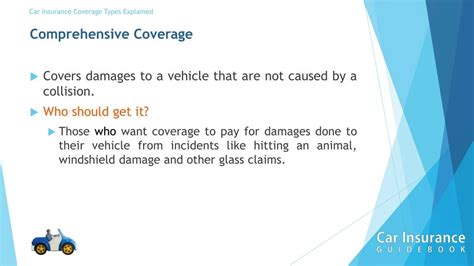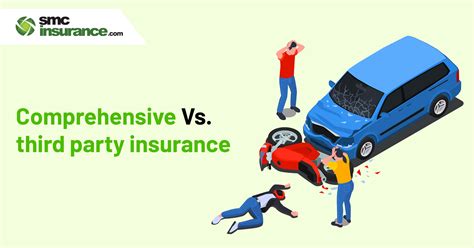What Does Auto Insurance Cover

Auto insurance, also known as car insurance or motor insurance, is a crucial aspect of vehicle ownership. It provides financial protection and coverage for various incidents and circumstances that may arise while operating or owning a vehicle. Understanding what auto insurance covers is essential for every driver, as it ensures peace of mind and helps mitigate potential financial risks. In this comprehensive article, we delve into the intricacies of auto insurance coverage, exploring the different aspects and scenarios it encompasses.
Comprehensive Coverage: Protecting Your Vehicle

One of the primary purposes of auto insurance is to safeguard your vehicle from a wide range of perils. Comprehensive coverage, often referred to as full coverage, is a popular choice for many vehicle owners. It offers protection against damage caused by events other than collisions, such as:
- Natural Disasters: Comprehensive coverage typically includes protection against damage caused by natural calamities like hurricanes, tornadoes, floods, or earthquakes.
- Vandalism and Theft: If your vehicle is vandalized, stolen, or damaged due to attempted theft, comprehensive coverage can provide financial relief.
- Animal Collisions: Hitting an animal on the road is an unfortunate but common occurrence. Comprehensive insurance often covers the costs associated with repairing your vehicle after such an incident.
- Fallen Objects: Whether it’s a tree branch falling on your car during a storm or debris from a construction site, comprehensive coverage can assist with the repairs.
- Fire and Explosions: Fire damage, whether caused by an accident or an external factor, is often covered under comprehensive insurance.
It’s important to note that while comprehensive coverage is extensive, it usually comes with a deductible. This means that you’ll have to pay a certain amount out of pocket before your insurance kicks in to cover the remaining costs.
Collision Coverage: Repairing After an Accident

Collision coverage is another essential aspect of auto insurance. It specifically addresses damage to your vehicle resulting from a collision with another vehicle or object. Here’s what it typically covers:
- Vehicle Repairs: Collision coverage is designed to help with the costs of repairing your vehicle after an accident, regardless of who is at fault.
- Single-Vehicle Accidents: Even if you’re the only vehicle involved in an accident, collision coverage can provide assistance in repairing your car.
- Collision with an Object: Whether you collide with a tree, a pole, or a fence, collision coverage can help cover the repair expenses.
- Hit-and-Run Accidents: If you’re involved in a hit-and-run incident and the responsible party cannot be identified, collision coverage can be a lifesaver.
Similar to comprehensive coverage, collision insurance usually comes with a deductible. The amount of the deductible can vary depending on your insurance policy and personal preferences.
Liability Coverage: Protecting Others
Liability coverage is a critical component of auto insurance as it protects you from financial losses if you are found legally responsible for an accident that causes injuries or property damage to others.
- Bodily Injury Liability: This coverage helps pay for the medical expenses and lost wages of individuals injured in an accident that you caused.
- Property Damage Liability: It covers the cost of repairing or replacing the property of others, such as another vehicle, fence, or building, that you damage in an accident.
- Legal Defense: In some cases, liability coverage may also provide legal defense if you are sued as a result of an accident.
Liability coverage is typically required by law in most states, and it’s important to ensure that you have adequate limits to protect your assets and financial well-being.
Personal Injury Protection (PIP) and Medical Payments
Personal Injury Protection (PIP) and Medical Payments (MedPay) coverage are designed to provide financial assistance for medical expenses incurred by you or your passengers after an accident, regardless of fault.
- PIP Coverage: PIP covers a wide range of medical expenses, including doctor visits, hospital stays, rehabilitation, and even lost wages and funeral expenses.
- MedPay Coverage: MedPay is similar to PIP but typically has a lower coverage limit and a faster claims process. It covers medical expenses for you and your passengers after an accident.
These coverages are especially beneficial as they ensure that you and your loved ones receive the necessary medical care promptly without having to worry about immediate financial strain.
Uninsured/Underinsured Motorist Coverage

Uninsured and underinsured motorist coverage protects you in situations where you’re involved in an accident with a driver who either has no insurance or has inadequate insurance coverage.
- Uninsured Motorist Coverage: This coverage pays for your injuries and property damage if you’re involved in an accident with an uninsured driver.
- Underinsured Motorist Coverage: It steps in when the at-fault driver’s liability coverage is insufficient to cover your damages and injuries.
Having uninsured and underinsured motorist coverage adds an extra layer of protection, ensuring that you’re not left financially burdened if you’re involved in an accident with an irresponsible driver.
Rental Car Coverage
If you’re involved in an accident and your vehicle is being repaired or is deemed a total loss, rental car coverage can provide assistance with the cost of renting a temporary vehicle.
- Rental Reimbursement: This coverage pays for a rental car while your vehicle is being repaired or until a replacement vehicle is obtained.
- Loss of Use Coverage: In some cases, insurance may also cover additional expenses, such as the cost of alternative transportation or temporary housing if your vehicle is incapacitated.
Rental car coverage ensures that you can maintain your daily routine and commute without interruption while your primary vehicle is being repaired or replaced.
Gap Insurance
Gap insurance, also known as guaranteed asset protection, is an optional coverage that bridges the gap between the actual cash value of your vehicle and the amount you still owe on your loan or lease.
- Totaled Vehicles: If your vehicle is deemed a total loss due to an accident, gap insurance can cover the difference between the insurance payout and the outstanding balance on your loan or lease.
- Depreciation: New vehicles lose value rapidly in the first few years of ownership. Gap insurance ensures that you’re not left with a financial burden if your vehicle is totaled during this period.
Gap insurance provides peace of mind, especially for those who lease their vehicles or have a significant loan balance.
Roadside Assistance and Towing Coverage
Auto insurance policies often include roadside assistance and towing coverage, providing valuable help when you’re stranded on the side of the road.
- Roadside Assistance: This coverage typically includes services like battery jumps, fuel delivery, tire changes, and even locksmith services if you lock your keys in the car.
- Towing Coverage: If your vehicle breaks down or is involved in an accident, towing coverage can help transport your vehicle to a repair shop or a safe location.
Having roadside assistance and towing coverage as part of your auto insurance policy ensures that you have a reliable support system when unexpected situations arise.
Custom Parts and Equipment Coverage
If you’ve invested in customizing your vehicle with additional parts or equipment, such as a stereo system, custom wheels, or performance enhancements, you’ll want to ensure that these items are covered by your insurance.
- Custom Parts Coverage: This coverage adds an extra layer of protection for the unique features and modifications you’ve made to your vehicle.
- Equipment Coverage: It covers the cost of repairing or replacing specialized equipment, ensuring that your vehicle’s value is fully accounted for.
Custom parts and equipment coverage is particularly beneficial for vehicle enthusiasts who have made significant investments in enhancing their rides.
Umbrella Insurance
Umbrella insurance is an additional layer of liability coverage that goes beyond the limits of your standard auto insurance policy. It provides extra protection for catastrophic losses and offers broader coverage.
- Excess Liability: Umbrella insurance kicks in when the liability limits of your auto insurance are exhausted, providing additional coverage for claims that exceed those limits.
- Broader Coverage: It covers a wider range of situations, including personal liability for accidents that occur on your property or while engaging in recreational activities.
Umbrella insurance is an excellent option for individuals with significant assets to protect, as it provides an extra safety net in the event of a major claim.
Table: Summary of Auto Insurance Coverages
| Coverage Type | Description |
|---|---|
| Comprehensive | Protects against non-collision incidents like natural disasters, theft, and vandalism. |
| Collision | Covers repairs after a collision with another vehicle or object. |
| Liability | Protects you from financial losses if you cause an accident resulting in injuries or property damage to others. |
| Personal Injury Protection (PIP) | Provides financial assistance for medical expenses for you and your passengers after an accident. |
| Medical Payments (MedPay) | Similar to PIP, covers medical expenses for you and your passengers. |
| Uninsured/Underinsured Motorist | Protects you if you’re involved in an accident with an uninsured or underinsured driver. |
| Rental Car Coverage | Covers the cost of renting a temporary vehicle while your primary vehicle is being repaired. |
| Gap Insurance | Covers the difference between the actual cash value of your vehicle and the amount owed on your loan or lease. |
| Roadside Assistance | Provides assistance with battery jumps, fuel delivery, tire changes, and more. |
| Custom Parts and Equipment | Covers the cost of repairing or replacing customized parts and equipment on your vehicle. |
| Umbrella Insurance | Provides excess liability coverage and broader protection for catastrophic losses. |

Conclusion: Understanding Your Coverage
Auto insurance is a multifaceted financial tool that offers protection and peace of mind for vehicle owners. By understanding the various coverages available, you can make informed decisions to ensure that you have the right level of protection for your specific needs. From comprehensive and collision coverage to liability protection and specialized add-ons, auto insurance policies can be tailored to fit your unique circumstances.
As you navigate the world of auto insurance, it’s essential to review your policy regularly and consult with your insurance provider to ensure that your coverage aligns with your current lifestyle and vehicle usage. By staying informed and proactive, you can drive with confidence, knowing that you’re adequately protected on the road.
FAQ
What is the difference between comprehensive and collision coverage?
+Comprehensive coverage protects against non-collision incidents like natural disasters, theft, and vandalism, while collision coverage specifically addresses damage resulting from a collision with another vehicle or object.
Is liability coverage mandatory?
+Liability coverage is typically required by law in most states. It’s important to ensure you have adequate limits to protect your assets and financial well-being.
What does PIP and MedPay coverage include?
+PIP and MedPay coverage provide financial assistance for medical expenses incurred by you and your passengers after an accident, regardless of fault. They cover a wide range of medical costs, including doctor visits, hospital stays, and rehabilitation.



